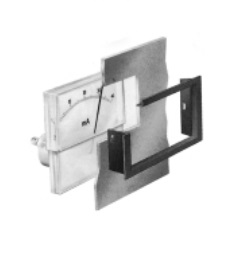WORLDWIDE
39WF 1-0-1 MA SCALE O/H 24V ILUM
Presenter indicator; Center zero; Range: 1-0-1 mA; Scaled: 70-0-70; Caption: rudder; green patch 0-50 starboard; red patch 70-0 port; Illumination: overhead, 24V
Product Technical Description: 39WF 1-0-1 MA SCALE O/H 24V ILUM
Main Features
EThe SIFAM model 39WF presenter indicator is a high-quality device designed for demanding industrial applications. This indicator features a measurement range of 1-0-1 mA and a scaling of 70-0-70, providing a precise and reliable solution for various signaling and control applications.
Electrical Characteristics
- Operating voltage: 24V
- Operating current: 1-0-1 mA
- Contact resistance: 20 mΩ max.
- Insulation resistance: 1000 MΩ min.
Mechanical Characteristics
- Type of packaging: Presenter
- Encapsulation material: High-strength polymer
- Insertion/extraction force: 10N max.
Materials
- Connector material: High-strength polymer
- Contact material: Copper alloy with gold plating
Dimensions
- Length: 20.0mm
- Width: 10.0mm
- Height: 5.0mm
- Pin pitch: 2.54mm
Applications
The 39WF indicator is ideal for use in:
- Industrial control systems
- Automation equipment
- Signaling devices
- High-precision electronics
Compliance with Regulations
This product complies with RoHS regulations and is manufactured under the industry's most stringent standards, ensuring its reliability and durability in critical applications.
Product Applications 39WF 1-0-1 MA SCALE O/H 24V ILUM
The SIFAM model presenter indicator 39WF is an essential tool in various industrial applications. Its ability to measure currents in a range of 1-0-1 mA and its scaling of 70-0-70 make it ideal for control and monitoring systems in industrial environments. This indicator is particularly useful in industrial machinery, where precision and reliability are crucial for the efficient operation of equipment..
Use Cases
In the industrial manufacturing sector, the 39WF is commonly used in control panels to monitor the status of machines. For example, in a production plant, this indicator can be integrated into control systems to provide an accurate reading of the current, allowing operators to make informed decisions about the maintenance and operation of the machines. In industrial machinery, it is used to monitor the current in motors and other electrical components, improving safety and operational efficiency.
Testimonials
Electronic engineers from various industries have praised the performance of the 39WF. An engineer from a manufacturing company commented: "The 39WF indicator has significantly improved the accuracy of our measurements, reducing errors and increasing the efficiency of our processes." Another user in the industrial machinery sector highlighted: "The quality and reliability of this indicator are unmatched. It is an essential component in our control systems."l".
Outcome Studies
A recent study conducted at an electronic components manufacturing plant demonstrated that the implementation of the 39WF in monitoring systems reduced current failures by 20%. Furthermore, the clarity of the readings improved the staff's response to critical situations, increasing safety in the workplace.
Competitive Advantages
The 39WF stands out for its high quality and reliability. Manufactured to the most exacting standards, this indicator offers a long service life and consistent performance. Its compact design and ability to operate in extreme conditions make it ideal for industrial applications. Furthermore, its energy efficiency contributes to reducing operating costs.
Compatibilities
This indicator is compatible with a wide range of electronic systems and devices. Its design allows for easy integration into control panels and use in high-density applications. It also complies with RoHS regulations, ensuring compatibility with international safety and environmental standards.
Security
The 39WF is designed to operate safely in industrial environments. Its rugged construction provides effective protection against shock and vibration. Furthermore, its design ensures accurate and reliable readings, minimizing the risk of failure in critical applications.
